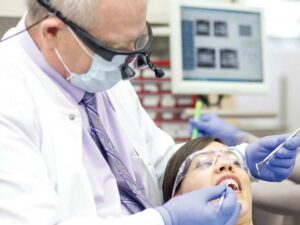Magnification’s Role in Today’s Dental Practice
If a picture is worth a thousand words, it follows that a clear view of the field of operation is priceless.
If a picture is worth a thousand words, it follows that a clear view of the field of operation is priceless. Oral health professionals can’t treat what they cannot clearly see, which is why magnification and illumination are indispensable clinical tools. Underscoring the importance of these technologies, Stephen K. Harrel, DDS, a periodontist and an adjunct professor in the Department of Periodontics at Texas A&M University College of Dentistry, notes, “I always use a combination of magnification methods. As a periodontist who exclusively performs minimally invasive procedures, I use medium magnification loupes (3.5x) for general visualization of the treatment field, and a videoscope (up to 40x) for higher magnification. In my experience, most dental procedures can be performed with magnification in the 2.5x to 5x range.”
Citing 3x to 5x magnification as a good range for most restorative dentistry, Harrel says these loupes offer adequate detail of the operating site, but still provide a wide enough field so the operator remains oriented to adjacent structures. Of course, while higher magnification allows greater precision when needed, it also narrows the field of vision. Thus, he advises trying several configurations and magnifications — including Keplerian loupes (3.5x to 8.0x) and Galilean loupes (2.0x to 3.5x) — before reaching a purchase decision.
Regarding the choice between fixed or variable magnification, Harrel points to advantages and disadvantages, saying, “Adjustable magnification loupes are heavier than single magnification setups, and the increased cost approaches that of a second set of loupes. It can be argued that buying two sets with different magnifications is a more reasonable option. While some dentists may find interchangeable magnification beneficial, most will discover that single magnification best serves their purposes.”

Noting the debate over through-the-lens (TTL) loupes and flip loupes has subsided because companies now offer much steeper angles of declination in TTL styles, he reports that some manufacturers will customize the angle of TTL loupes to suit clinician preference. In addition, TTL models offer a weight savings over flip styles.
While magnification is certainly useful, illumination can be equally beneficial. A proponent of headlamps, Harrel says that in order to take full advantage of magnification, operators need to have increased light available. With this goal, he notes that a color-corrected, adjustable LED headlamp will provide focused illumination that can be adjusted to the operator’s needs.
Although dental operating microscopes are generally associated with endodontics, Harrel observes they have been successfully used in almost all dental procedures. However, this technology has limitations. “My experience has been that operating microscopes are difficult to use unless the patient is immobilized, such as during general anesthesia,” he says. “And because the operating field must be visible in a direct line with the microscope lens, when a patient moves — even slightly — the microscope will need to be repositioned. In addition, because they are not in a direct line of vision, the distal and lingual aspects of many teeth can’t be easily visualized.”
Mostly used in periodontal therapy, endoscopes and videoscopes represent another advanced magnification aid — and one that Harrel says may benefit many areas of practice. An advocate of the dental videoscope, he cites the advantages of high magnification and flexibility in visualization. “Unlike surgical microscopes,” he says, “videoscopes can be used to inspect areas that cannot be directly visualized with a microscope or loupes, such as the distal of molars or areas under tissue flaps.”
With an eye on the future, Harrel observes the field of magnification is increasingly moving toward a digital approach. “Many medical procedures are now performed with the surgeon visualizing the operating field using a monitor,” he reports. “It is likely our profession will follow with increased use of digital magnification while performing dental procedures.”
From Decisions in Dentistry. March 2022;8(3):46.


